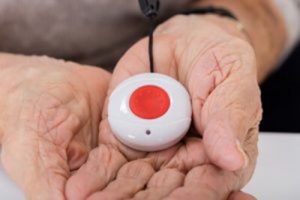
Did you know that each year, one in four Americans over age 65 takes a fall, which is the leading cause of disability in seniors? We certainly don’t mean to alarm you, but if you plan to age in place, you must take steps to prevent a fall, like getting rid of fall hazards, exercising or wearing the right kind of shoes.
Although you can easily reduce your risk of falling, the truth is you can’t guarantee that you won’t have an accident. So, what can you do to minimize the effects of a fall should one happen?
Our best advice is to invest in a personal emergency response system (PERS), a wearable device with a button that triggers a call to a response center, where an agent will either call 911 or your emergency contact. Not only that, but many medical alert systems have also evolved beyond getting emergency help and provide services like health monitoring and movement sensors.
Here’s a run-through of the type of systems and features you might find when looking for a PERS.
In-Home Systems
If you are a stay-at-home kind of person, consider a traditional in-home landline system that connects to a telephone jack. These models usually have a stationary base station and a clearly marked wearable help or emergency button. Another option is an in-home cellular home system, which would allow you to move the device around your house.
Wearable Base Stations
If you’re comfortable with mobile technology and have an active lifestyle, a mobile PERS might be a better choice as you can take them with you. These systems come with lightweight help buttons and mobile base stations that can be carried in a purse, worn as a pendant around your neck or clipped to a belt. Unlike classic models, you can activate the alert and speak and hear through it. Keep in mind that the built-in GPS capabilities of a mobile PERS mean that the call center can find out your exact location within moments.
There are even specialized mobile systems that plug into your car and come with crash detection and GPS. Other bells and whistles you can opt for include the following:
- Blood pressure and other vital signs monitoring
- Medication reminders
- Activity and fitness tracking
- Daily check-in services
- Motion detectors and beacons that track movement in the home
- Fire, smoke and carbon monoxide detection
Questions to Ask

Also, find out if the PERS is waterproof, as this will allow you to wear it in the shower, where many falls happen. Before you invest in a traditional system, ask how far the wearable help button can be from the base unit. (If you live in a large home with a big backyard, consider a service that offers a long-range pendant.) As well, check that it has a built-in battery backup in the event of a power outage.
Pricing
According to the PC Mag article, The Best Medical Alert Systems for 2020, a landline in-home system typically ranges in price from $25 to $35 per month, while cellular in-home subscriptions cost about $35 to $45, and mobile systems, up to $65 or $75 dollars per month., Medicare and private insurance companies don’t cover the costs of a medical alert system, although some insurers offer discounts.
Whatever you do, take the time to do your research to find the device that best meets your budget as well as your needs and lifestyle.
For more technology devices, check out our Smart Home Technology for Seniors article.
Contact us to learn about your senior living options.
